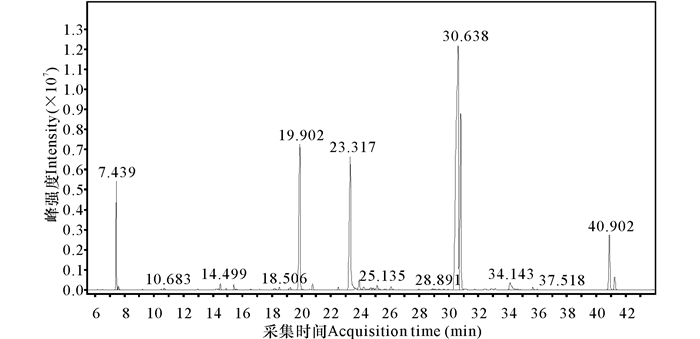2. 广西中医药研究院, 广西中药质量标准研究重点实验室,广西南宁 530022
2. Guangxi Key Laboratory of Traditional Chinese Medicine Quality Standards, Guangxi Institute of Traditional Medical and Pharmaceutical Science, Nanning, Guangxi, 530022, China
【研究意义】少花海桐(Pittosporum pauciflorum Hook.et Arn.)为海桐花科(Pittosporaceae)海桐花属(Pittosporum Banks)植物,常绿灌木,生于山地林中,分布于中国广西、广东、江西以及越南。它以茎皮入药为主,为经典瑶药“五虎”中的“上山虎”,瑶族常用其茎皮治疗风湿骨痛、胃脘痛、蛇毒咬伤、跌打损伤等[1-3]。【前人研究进展】据相关文献报道,刘元等[4]建立了少花海桐的薄层色谱鉴别方法,苏华等[5]研究发现少花海桐的水煮醇沉提取物对小鼠慢性及急性疼痛具有明显的镇痛作用,且具有抑制胃肠运动和止泻的功能,但有关少花海桐的化学成分研究目前未见报道。【本研究切入点】气相色谱-质谱联用(GC-MS)是目前公认为精油复杂成分定性鉴别的最有效手段[6],因此本研究运用GC-MS对瑶药少花海桐茎皮中挥发油的主要化学成分进行分析。【拟解决的关键问题】通过对少花海桐茎皮挥发油的主要化学成分进行分析鉴定,为其药材及制剂的质量控制提供参考,为少花海桐的综合利用及其天然精油的开发提供研究基础与科学依据。
1 材料与方法 1.1 材料少花海桐样品采集于广西省金秀县大瑶山,由广西中医药研究院中药资源研究所赖茂祥研究员鉴定为海桐花科海桐花属的少花海桐Pittosporum pauciflorum Hook.et Arn.。将新鲜茎皮切碎备用。
1.2 仪器Agilent 7890B-5977C气相色谱-质谱联用仪、Agilent 7693A自动进样器、MassHunter质谱工作站、NIST 11版质谱图库。
1.3 方法 1.3.1 挥发油提取称取预处理的少花海桐茎皮适量,按《中国药典》[7]2015年版中挥发油测定项下的规定方法对其挥发油进行提取,并计算茎皮中所含挥发油含量。所得挥发油经无水硫酸钠脱水后留用。
1.3.2 GC-MS分析色谱条件:色谱柱Agilent HP-5Ms(30 m×0.25 mm×0.25 μm)毛细管柱;初始温度100℃, 保持0 min,以2℃/min升温到220℃;进样量:0.2 μL;分流比:120︰1;流速:1.0 mL/min;进样口温度:250℃;传输线温度:280℃;离子源温度:230℃;四级杆温度:150℃;EI源;电子能量:70 eV;质量扫描范围:m/z 35~450 amu。
在上述GC-MS色谱分析条件下,对少花海桐茎皮中所提取的挥发油进行分离,对所测得的总离子流图经标准谱图库(NIST11) 检索,同时结合丛浦珠等[8]的研究确定各组分的化学成分,并采用面积归一法分别测定计算挥发油中各成分的峰面积相对百分比。
2 结果与分析少花海桐茎皮中挥发油含量约为0.09%。对所提取的挥发油经无水硫酸钠脱水后得淡黄色澄清油状液体,从中分离出29个组分(图 1),并确定了29个组分的化学成分(表 1);已鉴定成分峰面积达色谱总馏出峰面积的97.5%。少花海桐茎皮挥发油主要含有月桂醇酯(41.82%)、月桂醛(12.8%)、肉豆蔻醛(14.64%)、豆蔻醇(13.5%)、乙酸十四酯(4.54%)、十一烷(4.21%)等酯类、醛类、醇类、烷烃类化合物。

|
图 1 少花海桐茎皮挥发油总离子流图 Fig.1 Total ion flow diagram of volatile oil from bark of Pittosporum pauciflorum |
| 表 1 少花海桐茎皮挥发油成分GC-MS分析鉴定结果 Table 1 The chemical constituents of volatile oil from bark of Pittosporum pauciflorum analyzed by GC-MS |
瑶药少花海桐茎皮中挥发油含量约为0.09%,从中分离出了29个组分并全部鉴定,已鉴定成分峰面积达色谱总馏出峰面积的97.5%。挥发油主要成分为月桂醇酯(41.82%)、月桂醛(12.8%)、肉豆蔻醛(14.64%)、豆蔻醇(13.5%)、乙酸十四酯(4.54%)、十一烷(4.21%)等酯类、醛类、醇类、烷烃类以及烯烃类化合物。其中,月桂醇酯含量最高,为41.82%;月桂醛、肉豆蔻醛、豆蔻醇含量次之,所占百分比皆在10%以上;上述4种成分占总挥发油82.76%,故可确定瑶药少花海桐中挥发油的主要成分为以上4种。
少花海桐茎皮中的挥发油与已报道的同属植物海桐Pittosporum tobira (Thunb.) Ait.,海金子Pittosporum illicioides Makinou,狭叶海桐Pittosporum glabratum Lindl.var.neriifolium Rehd.et Wils,秀丽海桐Pittosporum pulchrum Gagnep.的挥发油[9-12]相比,皆有2~3种化学成分相同,且都以酯类、醛类、醇类成分含量高。月桂醛、月桂醇酯、肉豆蔻醛、肉豆蔻醇等成分具有良好的生物活性,已作为多种大分子有机物的主要合成原料在生物医学材料中被广泛应用。因其具有特殊的香味,也常被用作食品、化妆品的香精或添加剂。而少花海桐茎皮挥发油中该类成分含量较高,可将其作为天然挥发油进行开发利用,具有很好的发展前景。
| [1] |
中国科学院中国植物志编辑委员会. 中国植物志[M]. 北京: 科学出版社, 1979. Editorial Committee of Chinese Flora of the Chinese Acadamy Sciences. Flora of China[M]. Beijing: Science Press, 1979. |
| [2] |
戴斌. 中国现代瑶药[M]. 南宁: 广西科学技术出版社, 2009: 6-10. DAI B. China modern Yao medicine[M]. Nanning: Guangxi Science and Technology Publishing House, 2009: 6-10. |
| [3] |
方鼎, 张超良, 陆小鸿. 广西中药资源名录[M]. 南宁: 广西民族出版社, 1993: 176. FANG D, ZHANG C L, LU X H. List of traditional Chinese medicine resources in Guangxi[M]. Nanning: Guangxi National Publishing House, 1993: 176. |
| [4] |
刘元, 韦韡, 宋志钊. 少花海桐药材薄层色谱检测方法研究[J]. 中国民族民间医药杂志, 2012, 21(4): 51. LIU Y, WEI W, SONG Z Z. Study on detection method of Pittosporum TLC[J]. Chinese Journal of Ethnomedicine and Ethnopharmacy, 2012, 21(4): 51. |
| [5] |
苏华, 何飞, 韦韡, 等. 少花海桐提取物镇痛作用及对胃肠功能影响的研究[J]. 中国热带医学, 2015, 15(2): 137-140. SU H, HE F, WEI W, et al. Analgesic effects of water extraction and alcohol precipitation of Pittosporum pauciflorum on gastrointestinal functions[J]. China Tropical Medicine, 2015, 15(2): 137-140. |
| [6] |
刘布鸣, 柴玲. 色谱指纹图谱在精油质量分析中的应用研究进展[J]. 广西科学, 2015, 22(2): 135-142. LIU B M, CHAI L. Research progress of chromatographic fingerprint and its application in quality control of essential oil[J]. Guangxi Sciences, 2015, 22(2): 135-142. |
| [7] |
国家药典委员会. 中华人民共和国药典: 2015版四部[S]. 北京: 中国医药科技出版社, 2015: 203. State Pharmacopoeia Commission.Plarmacopoeia of the People's Republic of China:2015 edition, Volume 4[S]. Beijing:Chinese Medical Science Press, 2015:203. |
| [8] |
丛浦珠, 李笋玉. 天然有机质谱学[M]. 北京: 中国医药科技出版社, 2003. CONG P Z, LI S Y. Natural organic mass spectrometry[M]. Beijing: Chinese Medical Science and Technology Publishing House, 2003. |
| [9] |
江汉美, 李婷, 郭彧, 等. 海桐挥发油化学成分GC-MS分析[J]. 中国医药导报, 2011, 8(7): 29-31. JIANG H M, LI T, GUO Y, et al. Analysis of the chemical constituents of essential oil from Pittosporum tobira Ait.by GC-MS[J]. China Medical Herald, 2011, 8(7): 29-31. |
| [10] |
李娜. 海金子叶指纹图谱研究及其挥发油的GC-MS分析[D]. 长沙: 湖南中医药大学, 2013. LI N.Study on fingerprint analysed by HPLC and chemical constituents of volatile oil from leaves of Pittosporum illicioides by GC-MS[D]. Changsha:Hunan University Chinese Medicine, 2013. |
| [11] |
穆淑珍, 汪冶, 罗波, 等. 狭叶海桐挥发油的化学成分分析[J]. 中草药, 2004, 35(9): 980-981. MU S Z, WANG Y, LUO B, et al. Analysis of the chemical constituents of the volatile oil from Pittosporum glabratum[J]. Chinese Traditional and Herbal Drugs, 2004, 35(9): 980-981. |
| [12] |
黄云峰, 李振麟, 赖茂祥, 等. GC-MS分析秀丽海桐叶挥发油成分[J]. 广西科学, 2011, 18(1): 59-60, 63. HUANG Y F, LI Z L, LAI M X, et al. Analysis of the chemical constituent of volatile oil from leaves of Pittosporum pulchrum (Pittosporaceae) by GC-MS[J]. Guangxi Sciences, 2011, 18(1): 59-60, 63. |
 2017, Vol. 33
2017, Vol. 33 


